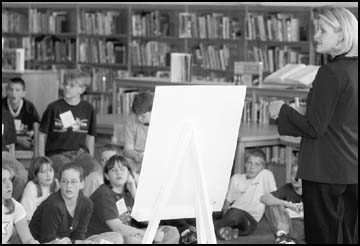 History is coming alive for sixth graders at Paynesville Area Middle School. A guest speaker spoke to them last week about the turn-of-the-century orphan trains, and students will have the opportunity to attend a play at the Great American History Theater in St. Paul on Wednesday, Dec. 1.
History is coming alive for sixth graders at Paynesville Area Middle School. A guest speaker spoke to them last week about the turn-of-the-century orphan trains, and students will have the opportunity to attend a play at the Great American History Theater in St. Paul on Wednesday, Dec. 1.Our students have been reading about how the orphan trains brought street children from New York City to the midwest in the late 19th century and early part of this century. An author, Joan Lowry Nixon, has written a series of five books about the orphan trains, and the sixth graders are reading the first book in the series in their English classes, taught by Jane Leitzman.
Last Thursday, a guest speaker was at the middle school to talk about the orphan trains and to spark interest for the upcoming play. Carrie Nevitt (pictured at far right), who is the daughter of the new high school librarian, Joan Nevitt, works for the Great American History Theater.
The orphan trains started in the late 1800s and ended in 1929. The New York Foundling Hospital and the Children's Aid Society organized the trains to reduce the number of children living on the streets in New York City. Not all of the children were actually orphans.
In those days, children could make a penny a week by working in a sweatshop, Nevitt told the students. If they were hungry and stole bread, they could get two to five years in jail if caught.
At first, the trains ran on the east coast, but gradually went farther and farther west, until the route stretched from New York City to Sacramento, Calif., and back. Nevitt had each student pin a number to their clothes and referred to each student by their number during her interactive presentation. Orphans on the trains, she explained, were called by number, not by name.
At each spot along the route, the children would disembark and be inspected by prospective families. Nevitt told the students how the children were poked and prodded, how their mouths were opened so their teeth could be examined, and how they were told they were too skinny or too fat.
If that wasn't degrading enough, she said, those not picked had to board the train again and look for parents at the next stop. Nevitt said the rejection must have been hard on the kids' self-esteem.
Nevitt met one man who rode the train from New York City to Sacramento and back, getting off at all the stops, but wasn't selected, probably on account of his slight limp. "Can you imagine," she asked, "...if no one wanted you after that?" Then he rode the train again, all the way to Sacramento, and wasn't adopted until the return trip through Kansas. Nevitt said he had a wonderful childhood with a loving family.
Not all the children were so lucky. Many were wanted more for labor than for love. Brothers and sisters could be split up. There was no charge for adopting and no background checks were done. The orphan trains have been called "white slavery."
One woman told Nevitt how she was adopted at age three by a 68-year-old woman, who simply wanted someone to take care of her.
The orphan trains, which may have carried up to 300,000 kids, regularly traveled through Minnesota. Out of an estimated 700 orphan train riders still alive nationwide, 50 live in Minnesota. Nevitt said St. Cloud, Becker, and Little Falls were frequent stops for the trains. There were also baby trains that carried kids under three years of age.
An estimated two million people are descendants of orphan train riders. Nevitt said the orphan trains still affect everyday life through these descendants.
The sixth graders were divided into two sessions to hear Nevitt. When she asked each class who benefitted from the orphan trains, the responses included the orphans with good families and New York City.
The sixth grade class has attended plays in the Twin Cities in the past. Last year, they saw "Afternoon of the Elves" at the Children's Theater in Minneapolis.
Nevitt gave the students a preview of the orphan train musical they will see next week. The play follows the lives of a number of children, portrayed by school-age actors, as they are recruited on the train and then sent west. Set in 1892, Nevitt warned our students that the play would not have a happy ending. "It's something to learn from to prevent mistakes in the future," she said.
After each performance, the actors lead a group discussion with members of the audience.
The Great American History Theater is in its 22nd year of operation. It is located in the old science museum building in St. Paul. The theater presents new and original works concerning Minnesota or midwestern history. The orphan train musical is in its third season and will run until the end of December.
Almost all of the sixth graders are expected to attend the performance. The students will be using proceeds from their annual candy bar sale to pay for part of the bus transportation. Each student will have to pay $1 for the bus, in addition to the price of their ticket.